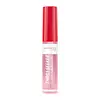What's inside
What's inside
 Key Ingredients
Key Ingredients

 Benefits
Benefits

 Concerns
Concerns

 Ingredients Side-by-side
Ingredients Side-by-side

Hydrogenated Polyisobutene
EmollientIsononyl Isononanoate
EmollientEthylene/Propylene/Styrene Copolymer
Diisostearyl Malate
EmollientPolybutene
Butylene/Ethylene/Styrene Copolymer
Tocopheryl Acetate
AntioxidantCocos Nucifera Oil
MaskingPassiflora Edulis Seed Oil
EmollientRubus Idaeus Seed Oil
EmollientUndaria Pinnatifida Extract
Skin ConditioningTocopherol
AntioxidantAroma
Caprylic/Capric Triglyceride
MaskingLimonene
PerfumingSynthetic Fluorphlogopite
Aluminum Hydroxide
EmollientPentaerythrityl Tetra-Di-T-Butyl Hydroxyhydrocinnamate
AntioxidantTriethoxycaprylylsilane
C20-24 Olefin
Skin ConditioningLinalool
PerfumingBHT
AntioxidantGeraniol
PerfumingAlumina
AbrasiveGlycerin
HumectantCI 19140
Cosmetic ColorantCI 15850
Cosmetic ColorantCI 77891
Cosmetic ColorantHydrogenated Polyisobutene, Isononyl Isononanoate, Ethylene/Propylene/Styrene Copolymer, Diisostearyl Malate, Polybutene, Butylene/Ethylene/Styrene Copolymer, Tocopheryl Acetate, Cocos Nucifera Oil, Passiflora Edulis Seed Oil, Rubus Idaeus Seed Oil, Undaria Pinnatifida Extract, Tocopherol, Aroma, Caprylic/Capric Triglyceride, Limonene, Synthetic Fluorphlogopite, Aluminum Hydroxide, Pentaerythrityl Tetra-Di-T-Butyl Hydroxyhydrocinnamate, Triethoxycaprylylsilane, C20-24 Olefin, Linalool, BHT, Geraniol, Alumina, Glycerin, CI 19140, CI 15850, CI 77891
Hydrogenated Polyisobutene
EmollientPolybutene
C12-15 Alkyl Benzoate
AntimicrobialTridecyl Trimellitate
EmollientEthylene/Propylene/Styrene Copolymer
Bis-Diglyceryl Polyacyladipate-2
EmollientButylene/Ethylene/Styrene Copolymer
Caprylyl Glycol
EmollientRicinus Communis Seed Oil
MaskingParfum
MaskingSilica Dimethyl Silylate
EmollientPentaerythrityl Tetra-Di-T-Butyl Hydroxyhydrocinnamate
AntioxidantTocopheryl Acetate
AntioxidantHelianthus Annuus Seed Oil
EmollientSodium Hyaluronate
HumectantStevia Rebaudiana Leaf/Stem Extract
MaskingEuterpe Oleracea Fruit Extract
Lycium Barbarum Fruit Extract
AstringentSambucus Nigra Fruit Extract
AstringentHydrogenated Castor Oil
EmollientTriethoxycaprylylsilane
CI 77891
Cosmetic ColorantCI 45410
Cosmetic ColorantCI 15850
Cosmetic ColorantIron Oxides
CI 19140
Cosmetic ColorantCI 42090
Cosmetic ColorantHydrogenated Polyisobutene, Polybutene, C12-15 Alkyl Benzoate, Tridecyl Trimellitate, Ethylene/Propylene/Styrene Copolymer, Bis-Diglyceryl Polyacyladipate-2, Butylene/Ethylene/Styrene Copolymer, Caprylyl Glycol, Ricinus Communis Seed Oil, Parfum, Silica Dimethyl Silylate, Pentaerythrityl Tetra-Di-T-Butyl Hydroxyhydrocinnamate, Tocopheryl Acetate, Helianthus Annuus Seed Oil, Sodium Hyaluronate, Stevia Rebaudiana Leaf/Stem Extract, Euterpe Oleracea Fruit Extract, Lycium Barbarum Fruit Extract, Sambucus Nigra Fruit Extract, Hydrogenated Castor Oil, Triethoxycaprylylsilane, CI 77891, CI 45410, CI 15850, Iron Oxides, CI 19140, CI 42090
Ingredients Explained
These ingredients are found in both products.
Ingredients higher up in an ingredient list are typically present in a larger amount.
We don't have a description for Butylene/Ethylene/Styrene Copolymer yet.
Ci 15850 is the pigment color red. It is an azo dye and created synthetically.
Azo dyes need to be thoroughly purified before use. This allows them to be more stable and longer-lasting.
This ingredient is common in foundations, lipsticks, and blushes. This color is described as brown/orangey red.
It has many secondary names such as Red 6 and Red 7. According to a manufacturer, Red 6 usually contains aluminum.
Learn more about CI 15850CI 19140 is also known as Tartrazine. Tartrazine is a synthetic dye used in cosmetics, foods, and medicine to add a yellow color.
Tartrazine is created from petroleum and is water-soluble.
Some people may experience allergies from this dye, especially asthmatics and those with an aspirin intolerance.
Learn more about CI 19140Ci 77891 is a white pigment from Titanium dioxide. It is naturally found in minerals such as rutile and ilmenite.
It's main function is to add a white color to cosmetics. It can also be mixed with other colors to create different shades.
Ci 77891 is commonly found in sunscreens due to its ability to block UV rays.
Learn more about CI 77891We don't have a description for Ethylene/Propylene/Styrene Copolymer yet.
Hydrogenated Polyisobutene is a synthetic polymer. Polymers are compounds with high molecular weight. Hydrogenated Polyisobutene is an emollient and texture enhancer.
In one study, Hydrogenated Polyisobutene showed better skin hydration levels than Caprylic/Capric Triglyceride. As an emollient, it helps keep your skin soft and hydrated by trapping moisture in.
Hydrogenated Polyisobutene is often used as a mineral oil replacement.
Learn more about Hydrogenated PolyisobutenePentaerythrityl Tetra-Di-T-Butyl Hydroxyhydrocinnamate (long name, huh?) is a synthetic antioxidant.
It is used to help stabilize other antioxidants or prevent the color from changing in a product.
As an antioxidant, it helps fight free-radical molecules. Free-radical molecules are capable of damaging our cells and other genetic material. Thus, antioxidants may reduce the signs of aging.
This ingredient is oil-soluble.
Learn more about Pentaerythrityl Tetra-Di-T-Butyl HydroxyhydrocinnamatePolybutene is used to help control the viscosity of a product. This just means it helps adjusts the texture.
It is a polymer and does not get absorbed into the skin due to its large size.
Studies found this ingredient did not irritate skin in concentrations below 15%.
Learn more about PolybuteneTocopheryl Acetate is AKA Vitamin E. It is an antioxidant and protects your skin from free radicals. Free radicals damage the skin by breaking down collagen.
One study found using Tocopheryl Acetate with Vitamin C decreased the number of sunburned cells.
Tocopheryl Acetate is commonly found in both skincare and dietary supplements.
Learn more about Tocopheryl AcetateTriethoxycaprylylsilane is a silicone used to bind and stabilize ingredients.
As an emulsifier, it helps prevent ingredients from separating. This can help elongate the shelf life of products.
Triethoxycaprylylsilane is often used to coat mineral sunscreens ingredients to help give a better feel. It also helps reduce oxidative stress in sunscreens.
Learn more about Triethoxycaprylylsilane